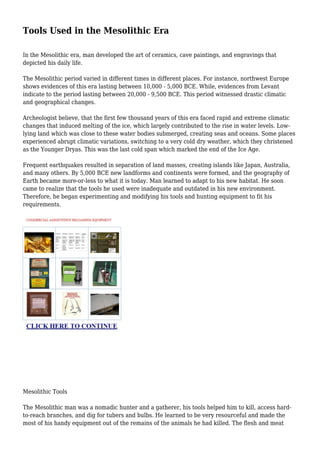
Tools Used in the Mesolithic Era
- 1. Tools Used in the Mesolithic Era In the Mesolithic era, man developed the art of ceramics, cave paintings, and engravings that depicted his daily life. The Mesolithic period varied in different times in different places. For instance, northwest Europe shows evidences of this era lasting between 10,000 - 5,000 BCE. While, evidences from Levant indicate to the period lasting between 20,000 - 9,500 BCE. This period witnessed drastic climatic and geographical changes. Archeologist believe, that the first few thousand years of this era faced rapid and extreme climatic changes that induced melting of the ice, which largely contributed to the rise in water levels. Low- lying land which was close to these water bodies submerged, creating seas and oceans. Some places experienced abrupt climatic variations, switching to a very cold dry weather, which they christened as the Younger Dryas. This was the last cold span which marked the end of the Ice Age. Frequent earthquakes resulted in separation of land masses, creating islands like Japan, Australia, and many others. By 5,000 BCE new landforms and continents were formed, and the geography of Earth became more-or-less to what it is today. Man learned to adapt to his new habitat. He soon came to realize that the tools he used were inadequate and outdated in his new environment. Therefore, he began experimenting and modifying his tools and hunting equipment to fit his requirements. Mesolithic Tools The Mesolithic man was a nomadic hunter and a gatherer, his tools helped him to kill, access hard- to-reach branches, and dig for tubers and bulbs. He learned to be very resourceful and made the most of his handy equipment out of the remains of the animals he had killed. The flesh and meat
- 2. were used as food, while other parts of the animal's body had varied uses, like their hide was used for clothing, teeth were used as jewelry, and bones were transformed into weapons. In this era, man learned that he could use other natural elements viz. wood, grass, clay, flint, reeds, and stones to make new tools and weapons. One such peculiarity of this era was man's way of using more than one material for making weapons. Mesolithic tools were essentially sharpened wood, bones, or antlers studded with tiny chips of stones, called microliths. These blades worked as barbed weapons. Mesolithic tools can be broadly divided into 3 main categories depending on their usage. ? Blades Flints were the preferred material to be used for making blades, including the microliths. Archeologists have found that many blades were carved out of a single piece of stone. ? Projectile Points Projectile points are objects joined to a projectile. These flints were larger and were often used as tips of arrowheads, spearheads, and other stabbing weapons. ? Scrapers The skins of animals killed by the Mesolithic man were used as clothing and also to make leather. To separate the meat from the skin, he required a special kind of blade called the scrappers. Scrapers were sharp flint that helped him peel the skin off his kill. Mesolithic man began using these varied new tools for newer uses like constructing canoes, and boats. However, making oars and nets was a skill he learned much later. The Mesolithic period came to an end as man abandoned his nomadic ways and began settling down and pursued agriculture and animal husbandry. He started hunting and fishing with others of his kind, which he soon came to realize, was beneficial in more ways than one. His weaponry and tool- making skills improved along the way as he stepped into the Neolithic era.